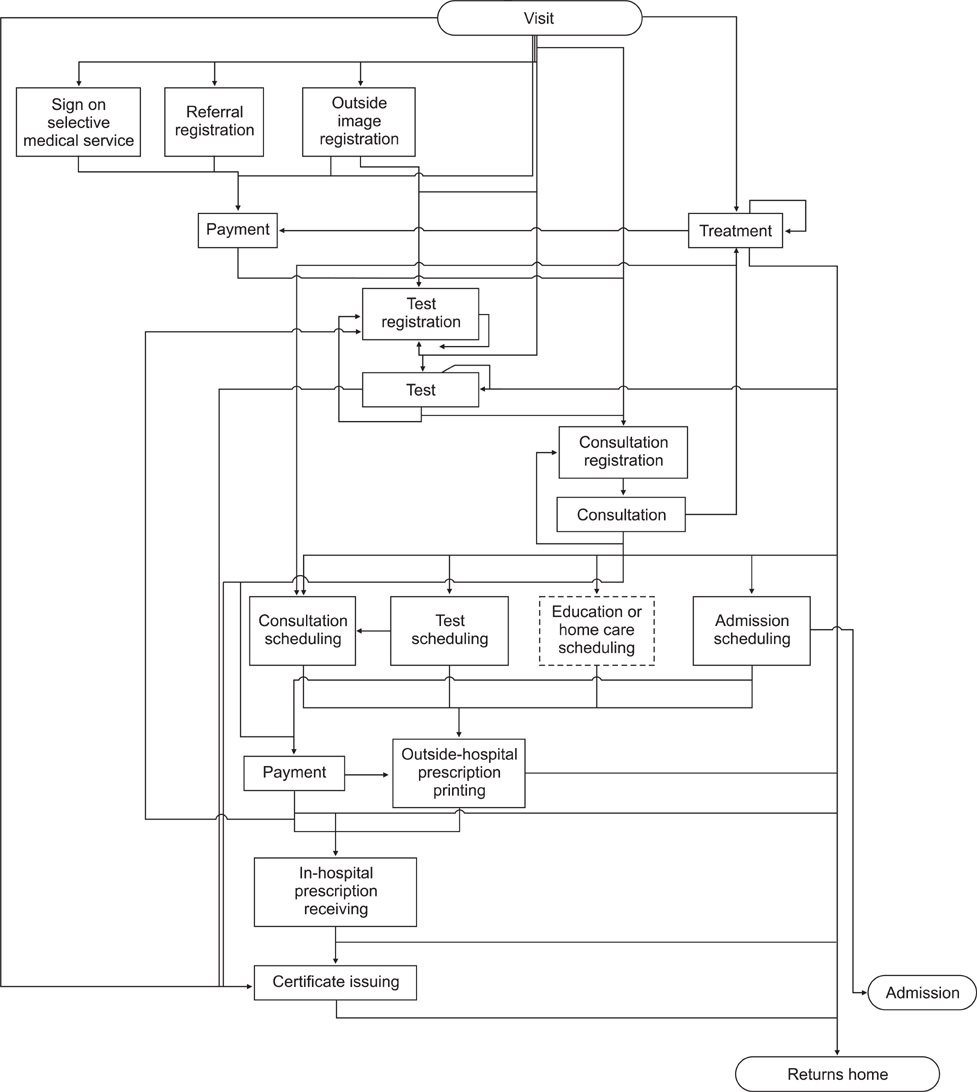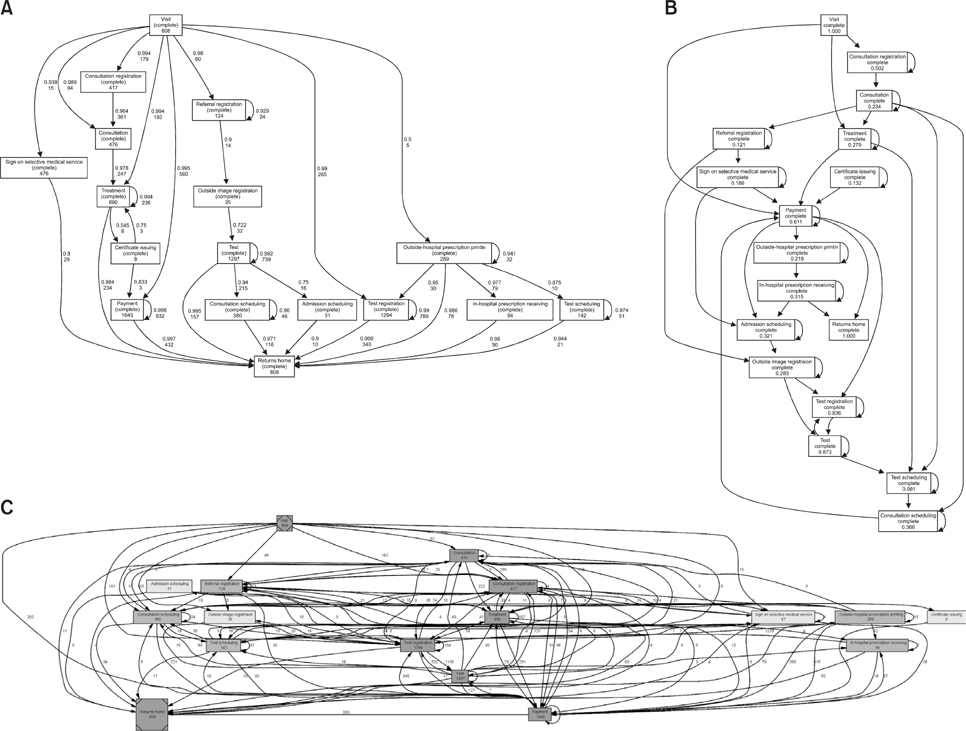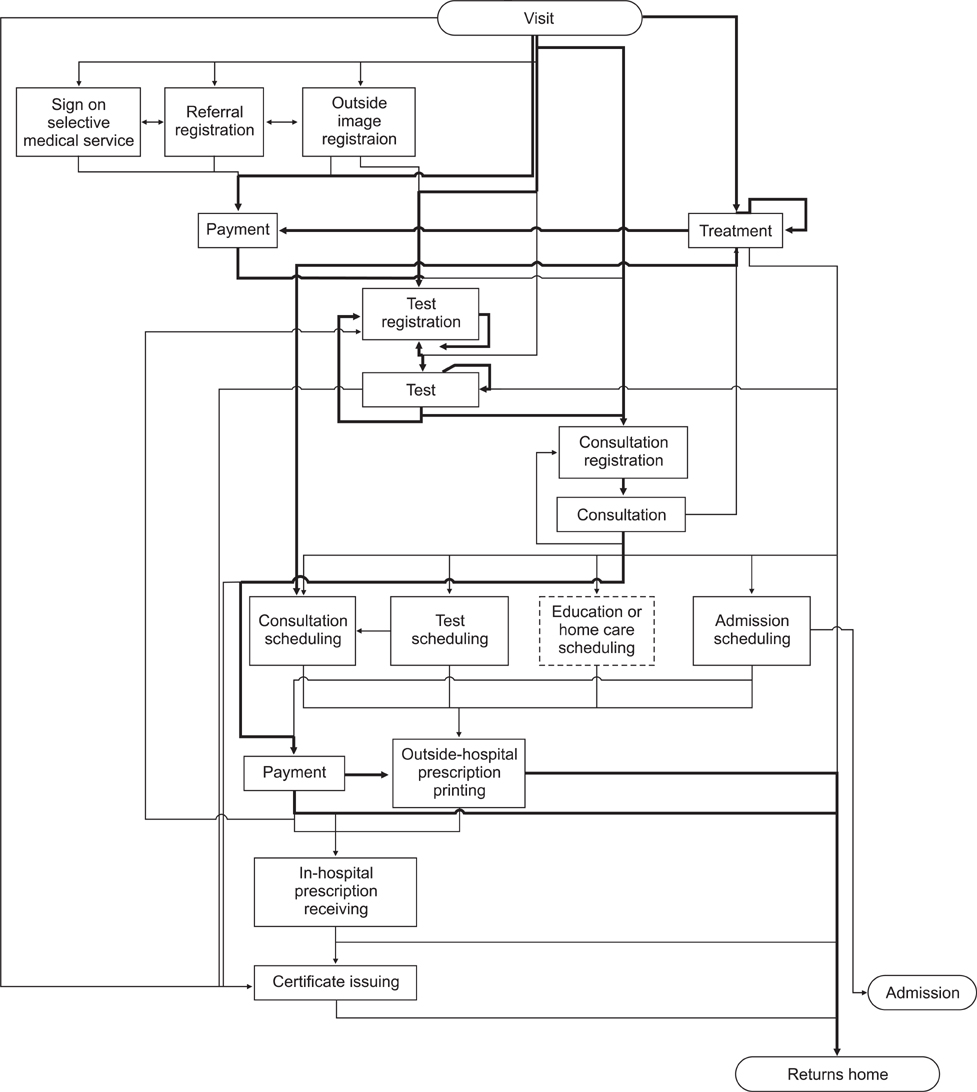Healthc Inform Res.
2013 Mar;19(1):42-49. 10.4258/hir.2013.19.1.42.
Discovery of Outpatient Care Process of a Tertiary University Hospital Using Process Mining
- Affiliations
-
- 1Center for Medical Informatics, Seoul National University Bundang Hospital, Seongnam, Korea. yoosoo0@snu.ac.kr
- 2School of Technology Management, Ulsan National Institute of Science and Technology, Ulsan, Korea.
- 3Cyberdigm Co., Seoul, Korea.
- 4Patient's Affairs, Seoul National University Bundang Hospital, Seongnam, Korea.
- KMID: 2166662
- DOI: http://doi.org/10.4258/hir.2013.19.1.42
Abstract
OBJECTIVES
There is a need for effective processes in healthcare clinics, especially in tertiary hospitals, that consist of a set of complex steps for outpatient care, in order to provide high quality care and reduce the time cost. This study aimed to discover the potential of a process mining technique to determine an outpatient care process that can be utilized for further improvements.
METHODS
The outpatient event log was defined, and the log data for a month was extracted from the hospital information system of a tertiary university hospital. That data was used in process mining to discover an outpatient care process model, and then the machine-driven model was compared with a domain expert-driven process model in terms of the accuracy of the matching rate.
RESULTS
From a total of 698,158 event logs, the most frequent pattern was found to be "Consultation registration > Consultation > Consultation scheduling > Payment > Outside-hospital prescription printing" (11.05% from a total cases). The matching rate between the expert-driven process model and the machine-driven model was found to be approximately 89.01%, and most of the processes occurred with relative accuracy in accordance with the expert-driven process model.
CONCLUSIONS
Knowledge regarding the process that occurs most frequently in the pattern is expected to be useful for hospital resource assignments. Through this research, we confirmed that process mining techniques can be applied in the healthcare area, and through detailed and customized analysis in the future, it can be expected to be used to improve actual outpatient care processes.
MeSH Terms
Figure
Cited by 2 articles
-
Dynamic Demand-Centered Process-Oriented Data Model for Inventory Management of Hemovigilance Systems
Mahnaz Sohrabi, Mostafa Zandieh, Behrouz Afshar Nadjafi
Healthc Inform Res. 2021;27(1):73-81. doi: 10.4258/hir.2021.27.1.73.Conformance Analysis of Clinical Pathway Using Electronic Health Record Data
Sooyoung Yoo, Minsu Cho, Seok Kim, Eunhye Kim, So Min Park, Kidong Kim, Hee Hwang, Minseok Song
Healthc Inform Res. 2015;21(3):161-166. doi: 10.4258/hir.2015.21.3.161.
Reference
-
1. Lenz R, Elstner T, Siegele H, Kuhn KA. A practical approach to process support in health information systems. J Am Med Inform Assoc. 2002. 9(6):571–585.
Article2. Anyanwu K, Sheth A, Cardoso J, Miller J, Kochut K. Healthcare enterprise process development and integration. J Res Pract Inf Technol. 2003. 35(2):83–98.3. Mans R, Schonenberg H, Leonardi G, Panzarasa S, Cavallini A, Quaglini S, et al. Process mining techniques: an application to stroke care. Stud Health Technol Inform. 2008. 136:573–578.4. van der Aalst WM, van Dongen BF, Herbst J, Maruster L, Schimm G, Weijters AJ. Workflow mining: a survey of issues and approaches. Data Knowl Eng. 2003. 47(2):237–267.
Article5. van der Aalst WM, Reijers HA, Weijters AJ, van Dongen BF, Alves de Medeiros AK, Song M, et al. Business process mining: an industrial application. Inf Syst. 2007. 32(5):713–732.
Article6. Van der Aalst WM, Weijters T, Maruster L. Workflow mining: discovering process models from event logs. IEEE Trans Knowl Data Eng. 2004. 16(9):1128–1142.
Article7. Gunther CW, van der Aalst WM. Fuzzy mining: adaptive process simplification based on multi-perspective metrics. Proceedings of the 5th International Conference on Business Process Management. 2007 Sep 24-28; Brisbane, Australia. 328–343.8. Yang WS, Hwang SY. A process-mining framework for the detection of healthcare fraud and abuse. Expert Syst Appl. 2006. 31(1):56–68.
Article9. Lin F, Chou S, Pan S, Chen Y. Mining time dependency patterns in clinical pathways. Int J Med Inform. 2001. 62(1):11–25.
Article10. Mans RS, Schonenberg MH, Song M, van der Aalst WM, Bakker PJ. Fred A, Filipe J, Gamboa H, editors. Application of process mining in healthcare: a case study in a Dutch hospital. Biomedical engineering systems and technologies. 2008. Heidelberg: Springer;425–438.
Article11. Song M, Yang H, Siadat S, Pechenizkiy M. A comparative study of dimensionality reduction techniques to enhance trace clustering performances. Expert Syst Appl. 2013. 40(9):3722–3737.
Article12. Rebuge A, Ferreira DR. Business process analysis in healthcare environments: a methodology based on process mining. Inf Syst. 2012. 37(2):99–116.
Article
- Full Text Links
- Actions
-
Cited
- CITED
-
- Close
- Share
- Similar articles
-
- Book Review: Process Mining: Discovery, Conformance and Enhancement of Business Processes
- Knowledge Discovery in Nursing Minimum Data Set Using Data Mining
- Development of Customer Relationship Management System in the Healthcare Domain Using Data Mining
- Knowledge Management Enablers and Process in Hospital Organizations
- Data Mining for High Dimensional Data in Drug Discovery and Development





